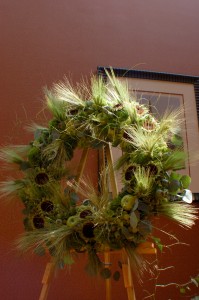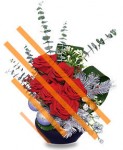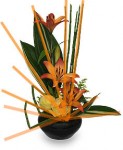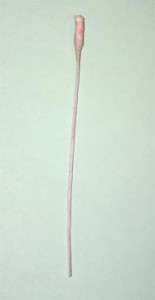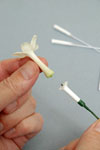As interior design expert Kelli Ellis puts it, “it’s far too easy to overlook natural beauty around us these days.” This is why it’s very important to look for elements that help create engagement in different spaces throughout the office, hotels and other public spaces.
Floral Trends: Enhancing Public Spaces
As interior design expert Kelli Ellis puts it, “it’s far too easy to overlook natural beauty around us these days.” This is why it’s very important to look for elements that help create engagement in different spaces throughout the office, hotels and other public spaces.
Floral Trends: Enhancing Wellness
Local Florist’s Quick Tips For DIY Flower Arranging
We just found this great video from back in 2007 that features one of our member florists and thought I’d share! Meghan Carter, host of Ask the Decorator visits with Vickey Wenshrup of Amelia Florist Wine & Gift Shop in Amelia, Ohio to learn a few DIY flower arranging pointers.
Don’t miss the video at the bottom of this post!
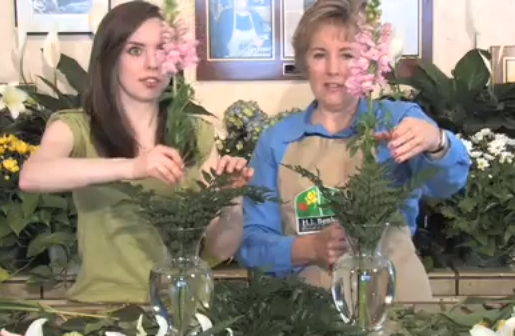
At the beginning of the video, Meghan asks, “How hard can it really be to make a floral arrangement?” By the end, she adds, “flower arranging isn’t as easy and you would think!” There is a whole lot more that goes into flower arranging that just putting flowers into a vase. Florists are truly artists, but also have to be meticulous in their efforts to keep your flowers lasting as long as possible. Sure you can DIY a flower arrangement, but for the absolute best results, give your local florist a call!
If you’re interested in DIY flowers, keep an eye out for workshops available in your area. Florists all over the country offer flower arranging classes where you can learn the ins and outs of creating flowers.
Keeping Hypericum Berries Fresh For Multiple Designs
Ask The Expert:
Please respond ASAP! I need to use fresh hypericum berry for corsages TOMORROW. How can I make them last through the Saturday eve wedding without water??
Flower Shop Network Plant Expert Reply:
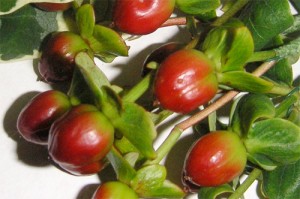 For this florist question, we went right to the source. We asked our florist friends and got an overwhelming response!
For this florist question, we went right to the source. We asked our florist friends and got an overwhelming response!
Hypericum berries are very hardy. If they came to you fresh, you should have no problems. For best results, use a little piece of tissue paper (facial or toilet) soaked in water at the bottom of the stem and wrap it as you would other flowers for a corsage. Keep them misted. Crowning Glory or Finishing Touch is also good to use to keep them fresher, longer. Be sure to keep them in the fridge at 38-40 degrees until you are ready to use them.
Hope this helps! Thanks for your inquiry.
And BIG thanks to all our florists who helped us out!
10 Ways To Put Life Back Into Your Dead Flowers!
The death of flowers are inevitable, and as florists, we deal with it a lot! There are, however, many creative ways to reuse these withered beauties to be enjoyed for many days, weeks or even months to come! We had a few ideas of our own, but we also asked our florist friends on Facebook for their input!
While They’re Still Kinda Fresh
1. Donate Before Flowers Are Too Gone
We have several florist friends who create short-lived flower arrangements out of their flowers that are about to expire. This is a great idea for florists who typically have a lot of extra flowers.
“Here at Gwinn’s Florist in Union, SC, we give our old flowers we wouldn’t send out to our local dialysis clinic right up the street from us, so their patients can enjoy them, even if it is for a day or two. :)” – Darlene
 “We at Old Dominion Florist take our extra flowers that are still ok for a day to the Nursing Home right up the street. We did this 4th of July when we shut down the cooler for the weekend!!!” – Becky
“We at Old Dominion Florist take our extra flowers that are still ok for a day to the Nursing Home right up the street. We did this 4th of July when we shut down the cooler for the weekend!!!” – Becky
“Extras are arranged in recycled vases and delivered to the local cancer center where they are given to patients undergoing chemo that day. Extras… never old or dead. We try to utilize extras for retirement centers, hospitals or the cancer center long before they are old. We love flowers and try to be good stewards of them.That is Spreading Sassy Sunshine!” – Linda, Sassy Floral & Design, St. Anthony ID
2. Use Flowers Deconstructed
Although they have withered, some flowers can still be used in arrangements in creative ways. You can strip the petals and use only the centers if they still look nice, or use the stems of the flowers to create unique lines in your designs.
Janet Frye of The Enchanted Florist in Asheville NC recommends using sunflower centers in arrangements. “Love it when sunflowers get older, so I can justify plucking out the petals and featuring just that beautiful brown center” – Janet
3. Create Works of Art With Flowers
Pressed flowers look beautiful on their own, however when arranged properly, they can be a true work of art. Just like creating arrangements, choose colors, sizes and textures that flow together and arrange them in unique ways on a flat piece of cardboard (such as the insert to a photo frame). Add a thin layer of acid-free glue to help the flowers stay in place. You can even cover the board in fabric or a nice paper (acid free works best and will make flowers last longer) to add to the look you’re going for.
To Wire or Not To Wire? That Is The Question
Ask The Expert: I am helping a friend with her wedding flowers and need some advise. She wants a cascading bouquet hand tied and made up from Phalaenopis orchids. She is getting married in Jan so it will be cold. We had intended to use around 8 stems and placing the longest at the bottom for the length and build up with the other stems to the sides and getting shorter as we go. After reading comments left here we now need to know if it is necessary to wire the heads? –Jayne
Flower Shop Network Plant Expert Reply: It is not necessary to wire your Phalaenopis orchids when using the whole stem in the cascading bouquet. If the stems of your orchids have great flowers, you might be able to use them whole. If you need more flower heads to make the bouquet fuller, you can wire in more flowers. If you DO wire the flowers in, make sure you leave this step until the very last.
To wire a Phalaenopis orchid, it’s suggest to use the hairpin wiring method and 24-26 gauge wire. Use a U-shaped, floral-taped wire for the Phalaenopis where the wire is positioned under the orchid’s throat. Add a wet cotton ball to the end of the stem then pull both ends down parallel to the stem and wrap in floral tape. This will provide the needed moisture for the flowers. Many florists recommend finishing it off with Crowning Glory floral spray to slow the deterioration and browning of your flowers and prolong freshness. Good luck!
This post is brought to you by local Honolulu florists.
Not in Honolulu HI? No worries, use Flower Shop Network’s handy directory of local florists to find a florist near you!
Elements of Design Part 1: LINE
The Elements of Design are a universal concept shared between designers everywhere. Whether you are a floral designer, furniture designer, graphic designer, or even something as crazy as a cheese sculpture designer, to be good, we all use the same, basic building blocks.
A good designer learns every aspect of his trade and uses the elements, along with the principles of design, to give their works an added little “oomph.” Anyone can put flowers in a vase, but only the most talented florists can tantalize your senses with their expertly crafted designs.
Using the right lines is important to convey your intended moods and emotions in your arrangements. Using line correctly, in conjunction with the other elements of design, can give your arrangement an overall finished, top-quality look.
Line [lahyn] Show-noun/laɪn/
- A visual path that directs eye movement through composition.
- Something arranged along a line, esp. a straight line; a row or series: a line of trees.
- A band of color, a seam, or a furrow: lines of stratification in rock.
- The edge of a shape.
We all know what a line is, right? Sure, a line is a visual path between point A and point B, but that is just the start of it!
TYPES OF LINE
Actual Lines are lines that are actually physically present. We may not think about it, but everything we use in our arrangements have line qualities in them. Leaves edges (curved, or straight) create line. Bands of color — such as a row of red roses amongst white ones creates line. Keep track of these little features in all your arrangements and you will train your eye to instantly see them.
-
IMPLIED LINE
Implied Lines are lines that are created by your mind’s eye. Your choice of composition makes it appear as though they were there. A connection of two similar visual elements, the continuation of a repeated element in the arrangement — there are many many ways to use implied lines.
-
STATIC LINE
A static line can be either vertical ( | ) or horizontal ( — ) and are at rest. These lines are not falling, leaning, or showing any potential for movement, so visually gives you the impression of rest. These static lines can give stability to an otherwise chaotic design.
Horizontal lines – calm, quiet, rest. (Frank Lloyd Wright architecture)
Vertical lines – more potential fore movement, reflect power and spirituality. (Think corporate buildings and cathedrals.)
If you have a design you think is too dynamic, try adding a static line of some form to balance the look.
-
DYNAMIC LINE
A dynamic line as a line that is not horizontal or vertical. This can be curved, zigzagged, slanted, diagonal; basically anything that is not static. Dynamic lines infuse the idea of movement into your flower arrangement because these lines are not at rest.
There are different degrees of dynamic lines in floral design as well. The softly curved edge of an Aspidistra leaf definitely gives you a different impression than a tangle of curly willow.
 PROPERTIES OF LINE
PROPERTIES OF LINE
- Vertical + Horizontal
When you combine vertical lines with horizontal lines you create a geometrically inspired structure. Because they are both static lines, this type of arrangement reflects strength, reliability, and safety. (Great for Fathers Day designs!)
- Curved Lines
Curved lines are those that gently relax into an arched shape. These are gentle, comforting lines. The human body is made up of curves, thus these lines are familiar, pleasing, and reflect relaxation and sensuality.
- Strong Lines
Strong lines are those that are bold and in your face such as bamboo or Equisetum. These must be positioned carefully and very purposefully and give your arrangement a crisp, tight look.
- Imperfect Lines
These are the types of lines that are rough, and jagged to create texture. These usually not used for the focal point in line designs.
How do you use line in your floral designs?
EXAMPLES OF LINE IN EVERYDAY ARRANGEMENTS
Leaf/Grass Design Techniques You Can Be Proud Of!
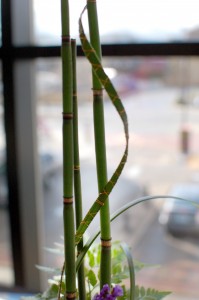
While I was at the AIFD Southern Conference, I noticed many designers using weaving techniques and other intricately designed tricks with their leaves. Above you see a leaf wrapped in copper wire and spiraling up three, straight Equisetum. This is a great visual effect that gives much needed movement to an otherwise static design.
In these videos, Regina Berryman, AIFD, CFD, our lead designer here at Flower Shop Network, shows us how easy it is to spruce up your foliage with these clever tricks. The first is a slightly complex weaving technique [Read more…]
Daffodils Flower Killer Or Urban Legend?
This afternoon I received a call from Sandy (Flower Shop Network customer service rep). With the tone of “say it isn’t so, Joe”, she asked me if daffodils would kill the other flowers in a mixed flower arrangement. As a defender of the lovely yellow flowers I replied, “I don’t think so.” It seems that she had been told that daffodils would kill other cut flowers. As I hung up the phone I wondered, why would someone speak slanderously about this delicate flower.
Now I was on a mission. I needed to find out if this was an urban legend or some daffodil secret I knew nothing of. I watch a lot of crime shows, CSI, Criminals Minds and my favorite The Mentalist. So I applied a few of their techniques to obtain my answer.
Here is what I know about daffodils. They are in the narcissus family and members of the narcissus family when cut produce a harmful stem clogging sap.
Here is what I know about making cut flowers last. Pre-treatments and pre-conditioning are a must for cut flowers. Pre-treatments are usually done by the growers. Pre-conditioning is a task performed by the receiving florist and very important for the longevity of cut flowers. Most flowers receive the same pre-conditioning as soon as they hit the door and you can go from one variety to another without any problems.
However, certain flowers need special procedures to ensure their health and the health of the flowers around them. This is true in the case of daffodils. They must be conditioned separately from all other flowers. Why? Because of the sap that drains from the stems when you cut them. If the sap is absorbed by the other flowers, it will clog their stems thus shutting off their ability to stay hydrated.
OK, here is where I see Urban Legend status emerging.
Some florist some where didn’t pre-condition their daffodils correctly. When flowers started dying in mixed flower arrangements containing daffodils, they blame the daffodils and not the conditioning practices of their shop. (This is kind of like blaming drinking water for cholera instead of the unsanitary practices that allowed waste material to flowing into the drinking water.) Of course this florist started spreading the word and all of a sudden a misunderstanding became an Urban Legend. This has probably caused some wonderful florists to believe that daffodils are flower killers. When in actuality, they can live harmonious with others as long as they are conditioned properly.
So for those of you convinced that the Urban Legend about Daffodils is true, try this experiment. Condition some daffodils the correct way and then arrange them with some flowers. Wait and watch. Do they last as long as any mixed flower arrangement would.
Follow these pre-conditioning steps for daffodils.
1. Prepare your daffodils after all other flowers have been prepped.
2. Fill a container with cool water and add a professional floral food. The water in the container should be shallow to avoid stem deterioration in the daffodils.
3. Cut at least 1/2″ off of the daffodil stem and place in the container with the floral solution.
4. Leave the daffodils in the container for at least 6 hours before you use them.
5. DO NOT recut the stems when arranging them. Cutting them will release the sap and you don’t want that to happen.
If you follow these steps, you shouldn’t have any trouble using daffodils with other flowers. Of course the best way to use daffodils with other flowers is in floral foam arrangements. You will have less of a chance of sap leakage in a foam arrangement than in a vase arrangement.
I hope my investigative skills have proven that the killer daffodil is an urban legend based on a simple misunderstanding.
***Tip for working with daffodils – For support insert a chenille stem or a section of leather leaf stem into the hollow of a daffodil stem and then insert it into the floral foam.***
How To Keep Stephanotis Fresh In A Bridal Bouquet
Ask the Expert: How to keep stephanotis fresh in bridal boquets
Tips For keeping cut stephanotis fresh. thanks Theda
Reply:
Theda,
Although I am not well versed on stephanotis, I do know this:
1. Stephanotis is a short lived cut flower and should be arranged as close to the time period needed as possible.
2. The oil on your finer tips can and will turn the blooms brown. So limit your touching or wear gloves when arranging stephanotis.
3. Bridal bouquet with stephanotis need to be misted frequently and have a damp tissue placed over the blooms.
4. Keep stephanotis bridal bouquets very cool. Warm air with accelerate the decline of the blooms.
I believe there is a special way to prep the stephanotis blooms by inserting something in the stem I will research this and discuss it with some of the designers I know and get back to you.
****Addendum***
I spoke with Regina Berryman an AIFD floral designer about the this issue. Regina told me that Stephanotis blooms have to be prepared with a cotton tipped wire called a Stephanotis Stem.
I am attaching a picture of one that was used in a Stephanotis arrangement.
Regina said insert it into the base of the Stephanotis bloom. ***Once this is done, you take a small container filled with water and take the flower and turn it upside down and dunk it into the water. This will keep the stephanotis hydrated and the wire will allow you to place the bloom in your arrangement. If you need to hide the white of the stem wrap it with floral tape. *** The cotton and the wire can be trimmed on an as need basis.
You should be able to find this type of wire at one of your floral suppliers. You can also create your own with cotton and regular floral wire. I hope this helps.
If any florist has pictures of how to do this I would love to post them on this blog.
**** I spoke with Regina who clarified my explanation above. (See *** section). She said that trying to make your own Stephanotis Stem is not easy and buying the Stepahnotis Stems is much easier and more cost effective. Stemson’s has a product called Stephanotis Stems. The stems come in white or green. The picture to left shows the Stephanotis stem as it is inserted into the Stephanotis bloom.


 Find Your
Find Your 